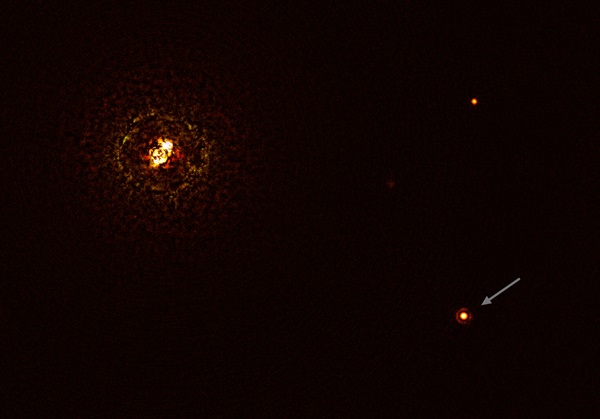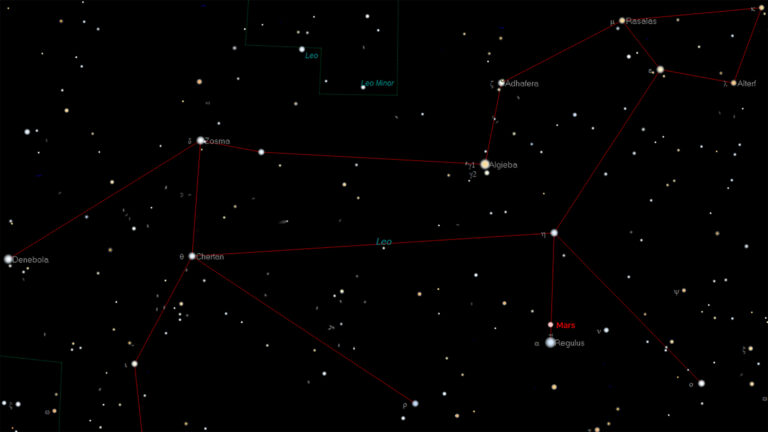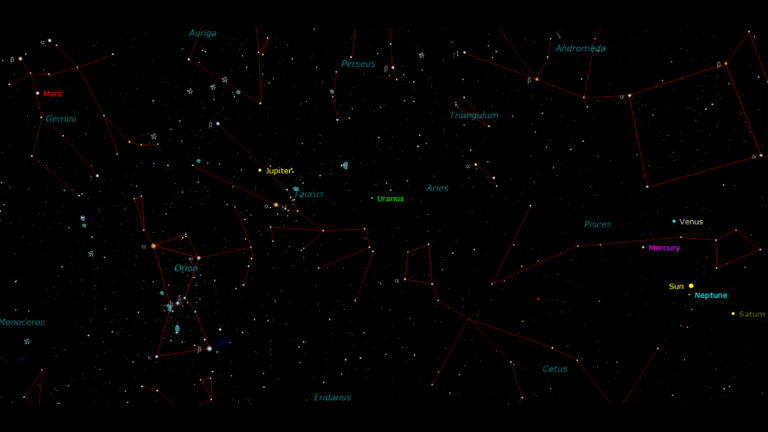Key Takeaways:
The planet b Centauri b arguably shouldn’t even exist — but the picture above is confirmation that it does.
The image, taken by the Very Large Telescope at the European Southern Observatory in Chile, shows the binary star system b Centauri at left, its two stars not quite resolved. At magnitude 4, b Centauri, located some 325 light-years away, is visible to the naked eye — though it is not to be confused with Beta (β) Centauri, which is one of the brightest stars in the sky.
The arrow in the image above points to the planet. By convention, the first discovered planet in a system is given the suffix “b”, which results in the unusual name: b Centauri b. It’s a gas giant orbiting its host stars at a distance roughly 560 times that of Earth from the Sun. This makes it one of the most distant exoplanet orbits yet found. (The apparent rings around the star and planet are image artifacts, and the object in the upper right is an unrelated background star.)
The planet’s mass is roughly 11 times that of Jupiter, which places it in the upper range of objects that can still called planets. Objects with masses of 13 Jupiters or more are classified as brown dwarfs, or failed stars.
But it’s the two host stars that make this system truly unlike any other astronomers have yet seen: The stars have an estimated combined mass of six to 10 times that of the Sun. That might not seem like much, but it’s at least twice the mass of any other known star (or stars) confirmed to host a planet. The system’s larger star is of spectral type B, the second-hottest category. And the problem with forming planets around such hot stars is that they emit lots of powerful ultraviolet and X-ray radiation, which ought to disrupt the planet-forming process.
“Finding a planet around b Centauri was very exciting since it completely changes the picture about massive stars as planet hosts,” said Markus Janson, an astronomer at Stockholm University in Sweden, in a statement. Janson is the first author of the new study, published Dec. 8 in Nature.
The find raises the possibility that b Centauri b formed through a different process than conventional theory predicts. That theory is a bottom-up model called core accretion, in which dust grains in the protoplanetary disk — which surrounds the fledgling star — begin glomming on to each other. Eventually, these snowballing dust grains grow to form concentrated planetary cores that begin to capture more rocky debris. If they’re massive enough, they can start collecting gas to form an atmosphere.
But perhaps a planet as massive as b Centauri b formed through a top-down process, more like a star: The planetary disk itself could have been large enough to support the existence of a gas cloud that eventually collapsed under its own weight, directly forming a planet.
Astronomers have reason to think there may be many more planets like b Centauri b that have been previously overlooked. That’s because most large direct imaging surveys to date have focused on Sun-like stars. There are also some planet candidates that have not yet been confirmed that orbit even more massive stars. Those include M51-ULS-1, a recent candidate discovered in the galaxy M51 that may be orbiting a binary system with a mass of at least 20 solar masses.
“We have always had a very solar system centric view of what planetary systems are ‘supposed’ to look like,” study co-author Matthias Samland, an astronomer at the Max Planck Institute for Astronomy in Heidelberg, Germany, said in a statement. But, he says, over the last decade, the diversity of discovered planetary systems has forced us to “widen our historically narrow view. This discovery adds another exciting chapter to this story, this time for massive stars.”











